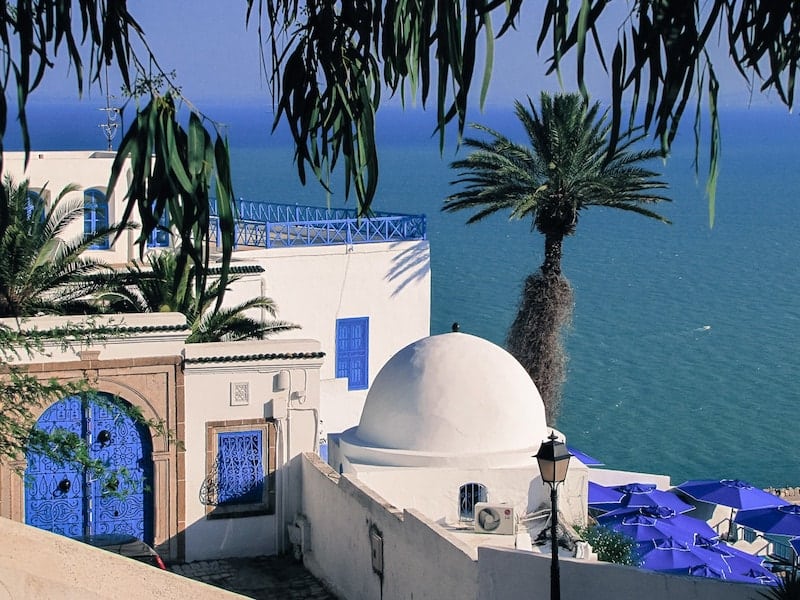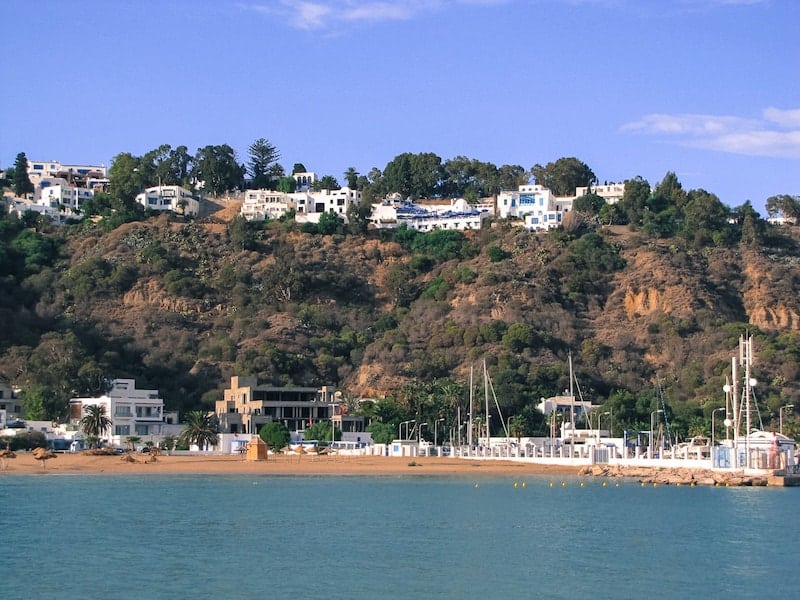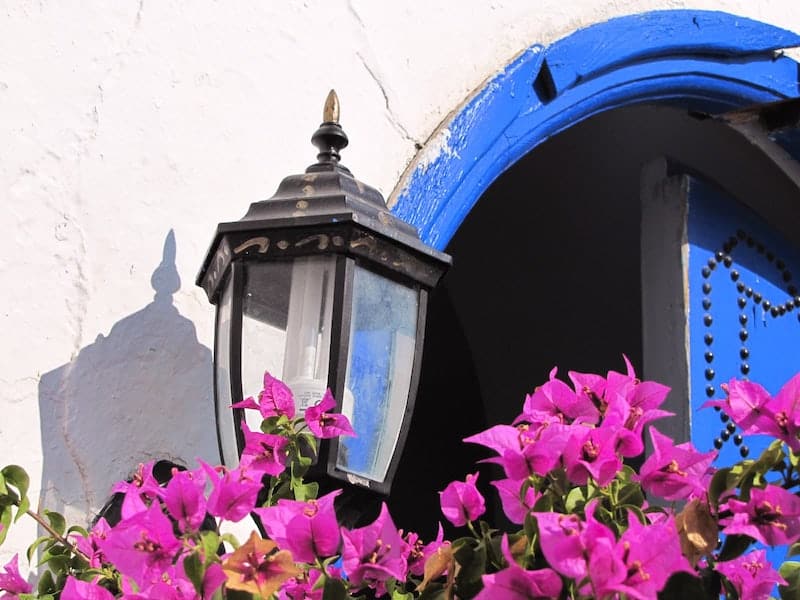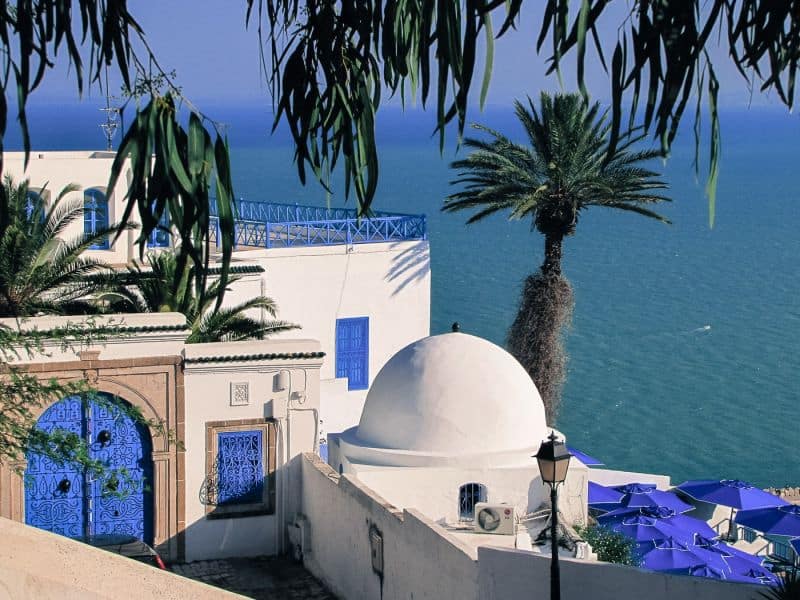
Tunisia’s Sidi Bou Said, with its clifftop setting, pretty whitewashed houses, and ornate blue doors, might just be the prettiest village you’ve never heard of.
WHAT IS SIDI BOU SAID? WHERE IS IT?
You might be forgiven for thinking that this sugar cube-and-blue village overlooking a turquoise sea is in Greece. With its colours and domes, it bears a certain resemblance to iconic Santorini. But Sidi Bou Said is just 18km by train from the Tunis, the capital of Tunisia.
The village is a breath of fresh air after busy Tunis and serves as a weekend getaway for the city’ artists, bohemian youth, families and elite, as well as being a key stop on the Tunisia itineraries of tours and cruises. It overlooks the luminescent Bay of Tunis, with a steep road leading down to a pleasant beach and marina.

Artists have long been attracted by the light and the colours here. The streets are blindingly bright in the midday sun, but the surroundings here are surprisingly lush, with pops of pink bougainvillaea and geraniums accenting the blue and white colour scheme. Stroll around the streets and you’ll spot the occasional rebellious red and yellow door.
Moucharabiehs—the name for the wooden latticework screens around balconies and windows — keep interiors cool but ventilated and provide a further canvas.
To top off the sensory feast, jasmine and orange blossom scent the air here, with secret gardens and flower-filled courtyards hidden amongst the streets.

Sidi Bou Said is a small village and a popular weekend escape for Tunisians. It’s easily accessible on the train line from Carthage. Families head for the beach and bohemian youth to the shisha cafes. Until recently it was also a popular day trip stop for the resorts fanning out along the coast and cruise liners docking at the nearby La Goulette port.
The village itself is lined with luxury houses built for wealthy politicians and is immaculately maintained. It’s a somewhat manicured version of the exotic but beautiful nonetheless.

Even with crowds, Sidi Bou Said somehow feels simultaneously touristy and undiscovered. It doesn’t take long to explore the tangle of narrow streets and there’s not much to do but recline in a variety of outdoor seating in cafes, people-watch and admire the sea views.
The evening brings a different atmosphere. You won’t find sunset cocktails here as the village faces west. Instead, the streets become silent as night falls and locals retreat to cafes in the modern end of town. Take a trip to Cafe De Nattes – the most famous cafe in town – for shisha in its ornate and unusual interior, or just enjoy having the moonlit streets to yourself.

WHAT TO DO IN SIDI BOU SAID
The most popular activity in Sidi Bou Said is to drink in the views from one of the numerous cafes or terraces. There is a road down to the beach at the base of the cliff if that turquoise water calls you.
Whilst you’re here, explore the legacy of the people who have shaped the village.
Abou Saïd Khalafa ben Yahia – this 13th-century teacher and Sufi retreated to the hilltop fort in later life and his presence was believed to protect Tunis from sea attacks. The village took his name and his tomb still attracts pilgrims (although it was largely burned in a fire in 2012). Many of the domed buildings were built in his honour.
Baron Rodolphe d’Erlanger – a French baron, musicologist and patron of the arts who moved to Sidi Bou Said in 1907. His hilltop palace, Dar Ennejma Ezzhara (the ‘The Star of Venus’ or ‘Sparkling Star’) hosted many musicians, artists and writers of the period, and is now a Museum of Arab and Mediterranean Music.
WHY IS SIDI BOU SAID BLUE AND WHITE?
‘The Baron’ poured funds into the village and lobbied the local government to grant it protected status, including the blue and white paint scheme. Sidi Bou Said now forms part of a UNESCO World Heritage site along with the nearby ruins of Carthage.
You can also make your way down the steep road to the beach for a day in the sun. You’ll find cafes, parasols, loungers and watersports available (I tried windsurfing! It’s much more difficult than it looks).

SIDI BOU SAID’S BOHEMIAN HERITAGE
In the 19th and 20th centuries, Sidi Bou Said became a popular retreat for writers and artists: Flaubert, Chateaubriand, Simone de Beauvoir, and Matisse all passed through. Most famously, Klee, Macke and Moilliet made the ‘Journey to Tunis’ in 1914; the resulting paintings and sketches are a highlight of early Modernism.
The village retains its artistic influence; the streets are dotted with small galleries, workshops and traders. The local speciality craft here is wire bird cages which echo the village with their domed shapes and ornate blue and white filigree. Hunt out the workshop of Azouz Samouda to purchase the original and best.

WHAT TO EAT
Restaurant food here is, in general, disappointingly mediocre. Stick to street food and simple classics. You can’t go wrong with salade tunisienne – Tunisia’s take on a niçoise, with tuna, olives, and harissa.

The same goes for briks. A thin deep-fried filo pastry, briks distinguish themselves with their circular shape and addition of runny egg yolk to a spicy tuna or mince filling. I don’t know why these haven’t taken over the world yet.
Cafes are notable for their views rather than the food so head to Café Sidi Chabaane or Cafes des Delices for your mint tea with pine nuts (thé aux pignons). Round it all off with bambaloni, a traditional doughnut, from one of the street traders.

WHERE TO STAY
Sidi Bou Said is short on budget options (there’s no hostel) but excellent for chi chi mid-range. Deal-hunters might also consider nearby resorts such as La Marsa.
Best luxury hotel ($130/£100 +):
Dar Said is the classic luxe option in town. This beautiful historic hotel is riad-style with 24 intricately-decorated rooms around a central courtyard, a small outdoor pool with views across the Mediterranean, and a hammam for guests.
Best boutique hotels ($70/£60 +):
- Hotel Bou Fares is your opportunity to stay in a traditional riad accommodation with lovely tiled interiors and a patio for relaxing.
- Dar Fatma has an Instagrammable rooftop pool and its clean minimalist white rooms are a bit less than Dar Said.
- Chambre Verte is a clean bright guesthouse in the white-and-blue style; all rooms have a bathroom.
- Dar el Fell is a charming artsy hotel with quirky and colourful rooms and a rooftop with sea views for relaxing.
Best Airbnb listings:

HOW TO GET TO SIDI BOU SAID
The ‘Blue Train’ links with Tunis Sidi Bou Said and the nearby Carthage ruins. Trains leave Tunis Marine TGM station in the Ville Nouvelle every 15 mins, take 35 minutes to Sidi Bou Said, and cost around 2 dinars.
TOURS TO SIDI BOU SAID
It’s not really necessary to take a tour to Sidi Bou Said as the train is very easy to use and. That said, if you’re only in Tunis for a short amount of time and want to pack a lot into one then tours are available which include nearby sites such as the Bardo Museum, Carthage, or a guided tour of Tunis Medina.
IS IT SAFE TO VISIT TUNISIA?
I was lucky enough to visit Sidi Bou Said before the Arab Spring whilst sailing across the Mediterranean with the Phoenician Ship Expedition.
The UK Government has now declared most of Tunisia safe for travel again*, following improvements in security in the main tourist areas. Previously it had advised against all non-essential travel following terrorist attacks in 2015.
* Parts of the south and interior and certain areas near the borders with Algeria and Libya should still be avoided, and vigilance is advised at religious sites and during festivals. See the FCO page for further information.
Found this post useful? Click to save to Pinterest:








